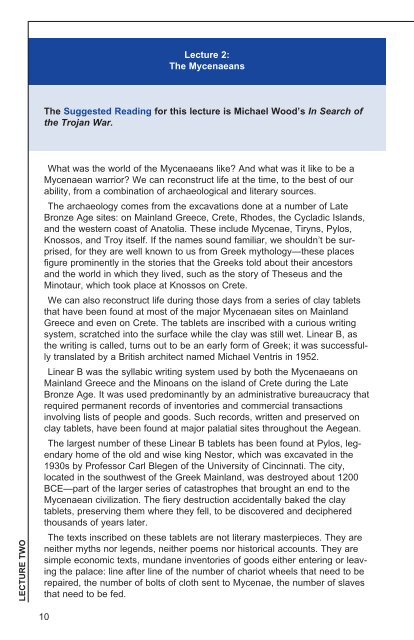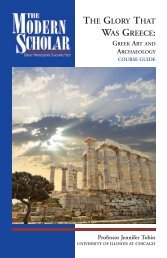The Trojan War in Homer and History - Recorded Books
The Trojan War in Homer and History - Recorded Books
The Trojan War in Homer and History - Recorded Books
Create successful ePaper yourself
Turn your PDF publications into a flip-book with our unique Google optimized e-Paper software.
LECTURE TWO<br />
Lecture 2:<br />
<strong>The</strong> Mycenaeans<br />
<strong>The</strong> Suggested Read<strong>in</strong>g for this lecture is Michael Wood’s In Search of<br />
the <strong>Trojan</strong> <strong>War</strong>.<br />
What was the world of the Mycenaeans like? And what was it like to be a<br />
Mycenaean warrior? We can reconstruct life at the time, to the best of our<br />
ability, from a comb<strong>in</strong>ation of archaeological <strong>and</strong> literary sources.<br />
<strong>The</strong> archaeology comes from the excavations done at a number of Late<br />
Bronze Age sites: on Ma<strong>in</strong>l<strong>and</strong> Greece, Crete, Rhodes, the Cycladic Isl<strong>and</strong>s,<br />
<strong>and</strong> the western coast of Anatolia. <strong>The</strong>se <strong>in</strong>clude Mycenae, Tiryns, Pylos,<br />
Knossos, <strong>and</strong> Troy itself. If the names sound familiar, we shouldn’t be surprised,<br />
for they are well known to us from Greek mythology—these places<br />
figure prom<strong>in</strong>ently <strong>in</strong> the stories that the Greeks told about their ancestors<br />
<strong>and</strong> the world <strong>in</strong> which they lived, such as the story of <strong>The</strong>seus <strong>and</strong> the<br />
M<strong>in</strong>otaur, which took place at Knossos on Crete.<br />
We can also reconstruct life dur<strong>in</strong>g those days from a series of clay tablets<br />
that have been found at most of the major Mycenaean sites on Ma<strong>in</strong>l<strong>and</strong><br />
Greece <strong>and</strong> even on Crete. <strong>The</strong> tablets are <strong>in</strong>scribed with a curious writ<strong>in</strong>g<br />
system, scratched <strong>in</strong>to the surface while the clay was still wet. L<strong>in</strong>ear B, as<br />
the writ<strong>in</strong>g is called, turns out to be an early form of Greek; it was successfully<br />
translated by a British architect named Michael Ventris <strong>in</strong> 1952.<br />
L<strong>in</strong>ear B was the syllabic writ<strong>in</strong>g system used by both the Mycenaeans on<br />
Ma<strong>in</strong>l<strong>and</strong> Greece <strong>and</strong> the M<strong>in</strong>oans on the isl<strong>and</strong> of Crete dur<strong>in</strong>g the Late<br />
Bronze Age. It was used predom<strong>in</strong>antly by an adm<strong>in</strong>istrative bureaucracy that<br />
required permanent records of <strong>in</strong>ventories <strong>and</strong> commercial transactions<br />
<strong>in</strong>volv<strong>in</strong>g lists of people <strong>and</strong> goods. Such records, written <strong>and</strong> preserved on<br />
clay tablets, have been found at major palatial sites throughout the Aegean.<br />
<strong>The</strong> largest number of these L<strong>in</strong>ear B tablets has been found at Pylos, legendary<br />
home of the old <strong>and</strong> wise k<strong>in</strong>g Nestor, which was excavated <strong>in</strong> the<br />
1930s by Professor Carl Blegen of the University of C<strong>in</strong>c<strong>in</strong>nati. <strong>The</strong> city,<br />
located <strong>in</strong> the southwest of the Greek Ma<strong>in</strong>l<strong>and</strong>, was destroyed about 1200<br />
BCE—part of the larger series of catastrophes that brought an end to the<br />
Mycenaean civilization. <strong>The</strong> fiery destruction accidentally baked the clay<br />
tablets, preserv<strong>in</strong>g them where they fell, to be discovered <strong>and</strong> deciphered<br />
thous<strong>and</strong>s of years later.<br />
<strong>The</strong> texts <strong>in</strong>scribed on these tablets are not literary masterpieces. <strong>The</strong>y are<br />
neither myths nor legends, neither poems nor historical accounts. <strong>The</strong>y are<br />
simple economic texts, mundane <strong>in</strong>ventories of goods either enter<strong>in</strong>g or leav<strong>in</strong>g<br />
the palace: l<strong>in</strong>e after l<strong>in</strong>e of the number of chariot wheels that need to be<br />
repaired, the number of bolts of cloth sent to Mycenae, the number of slaves<br />
that need to be fed.<br />
10






